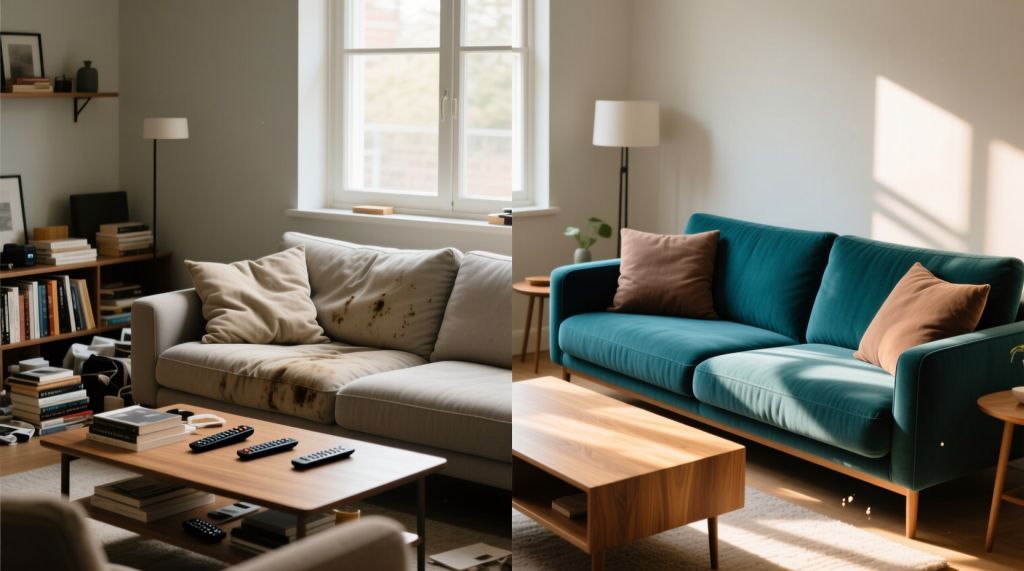Your sofa is a key piece in your living space, but wear and tear can make it look tired. Stains, flat cushions, or a creaky frame might suggest it’s time for a change. While full reupholstery can restore it completely, it’s costly and often more than needed. With targeted fixes, you can revive your sofa’s look and feel for less. Here’s how to bring your sofa back to life step by step.
Step 1: Inspect Your Sofa Closely
Start by giving your sofa a thorough inspection. Sit on it, lean back, and note any issues that stand out.
Check for:
- Cushions: Are they flat, lumpy, or uneven?
- Frame: Does it creak, shift, or feel unstable?
- Fabric: Are there stains, tears, or thinning areas?
- Smells: Do pet, food, or smoke odors persist?
This evaluation helps you identify whether you’re dealing with cosmetic issues, like stains or worn cushions, or structural problems, like a damaged frame. Surface fixes are often DIY-friendly, while deeper repairs may require professional sofa upholstery services.
Step 2: Clean It Thoroughly
A deep clean can make a sofa look significantly better, often revealing its potential.
Follow these steps:
- Vacuum deeply: Use a brush attachment for fabric and a crevice tool for seams.
- Spot-clean stains: Test cleaners on a hidden spot first. Use mild detergent for washable fabrics or a solvent for delicate ones.
- Steam carefully: Steam cleaning can refresh fabrics but may damage delicate materials. Check the care tag or consult an expert.
A thorough clean can lift dirt, brighten colors, and reduce odors, giving your sofa an immediate boost.
Step 3: Revive the Cushions
Sagging or lumpy cushions can drag down a sofa’s comfort and appearance. You don’t always need new ones—just better filling.
Options include:
- Fluff or rotate: Rearrange cushions to even out wear.
- Replace foam: Swap old foam for high-density options to restore shape.
- Add soft inserts: Feather or fiber fillings add a cozy feel.
A mix of firm and soft materials creates the best comfort. Sofa upholstery services can suggest the right foam or filling for your sofa’s needs.
Step 4: Repair Small Fabric Issues
Minor tears, frays, or worn spots can often be fixed without replacing all the upholstery.
Consider:
- Patching or re-stitching damaged areas.
- Replacing only heavily worn sections, like seat or armrest fabric, with a matching material.
These repairs are cost-effective and maintain the sofa’s original look.
Step 5: Try a Slipcover
If the fabric is dated but intact, a slipcover can transform the sofa’s appearance.
- Pre-made slipcovers: Budget-friendly and easy to wash.
- Custom slipcovers: Tailored to fit perfectly, preserving the sofa’s shape.
Slipcovers are ideal for protecting the original fabric and refreshing the style, especially in busy households.
Step 6: Update Minor Features
Small tweaks can modernize a sofa:
- Replace old legs with sleek, contemporary ones.
- Swap faded trim or piping for new material.
- Add decorative studs for a refined look.
These changes are quick and can shift the sofa’s aesthetic dramatically.
Step 7: Remove Odors
Smells from pets, spills, or smoke can cling to a sofa. To eliminate them:
- Sprinkle baking soda, let it sit, then vacuum it off.
- Air cushions in sunlight to neutralize odors naturally.
- Use enzyme cleaners for tough smells.
If odors remain in the padding, sofa upholstery services can replace the inner layers without a full reupholstery.
Step 8: Fix the Frame and Springs
A noisy or wobbly sofa often points to frame or spring issues, but these can be repaired without rebuilding the piece.
A professional can:
- Secure loose joints with glue or screws.
- Replace or retie sagging springs.
- Add support webbing for extra stability.
These fixes restore comfort at a lower cost than reupholstery.
Step 9: Protect Your Sofa
Keep your refreshed sofa looking great:
- Apply a fabric protector (check compatibility first).
- Condition leather regularly to prevent drying or cracking.
- Set rules like no food or pets on the sofa.
Regular care helps your sofa stay fresh longer.
Step 10: Seek Professional Help
For complex repairs or valuable sofas, professional sofa upholstery services, like Z.Mivins, ensure quality results. They can:
- Replace foam or padding.
- Repair frames or springs.
- Create tailored slipcovers.
- Fix fabric damage.
Experts can also tell you if a refresh is enough or if reupholstery is the better option.
Step 11: Plan Your Budget and Timeline
Repair costs vary:
- Cleaning and minor fixes: $50–$250.
- Cushion refills or slipcovers: $200–$600.
- Frame or spring repairs: $500–$1000.
Cleaning might take a day, while structural fixes could take a week. Check if delivery is available.
Conclusion
Refreshing a sofa doesn’t have to mean rebuilding it. Start small: clean it, fix what’s worn, refresh the cushions, and replace details that date the design. You’ll be surprised how much life the piece still has.
When you need help, talk to a trusted professional like Z.Mivins, who can handle everything from cushion refills to fabric repairs. The goal isn’t just to make the sofa look good—it’s to make it comfortable again, so you can keep enjoying it for many years.


